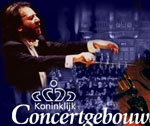|
|
|
[INDEX]
 Regular
visitors to Carnegie Hall can hear dozens of international orchestras
on tour but only a handful can be called truly great. Amsterdam’s Royal
Concertgebouw Orchestra is one of them, a magnificent ensemble with a
storied history that manages to live up to its reputation. The band tours
frequently and Carnegie Hall recently enjoyed two of the 34 concerts they
will perform outside the Netherlands this year. Regular
visitors to Carnegie Hall can hear dozens of international orchestras
on tour but only a handful can be called truly great. Amsterdam’s Royal
Concertgebouw Orchestra is one of them, a magnificent ensemble with a
storied history that manages to live up to its reputation. The band tours
frequently and Carnegie Hall recently enjoyed two of the 34 concerts they
will perform outside the Netherlands this year.
On February 5, Chief Conductor Riccardo Chailly (photo left) led a nicely
balanced program that opened with Three Preludes (1994) by the late Dutch
composer Tristan Keuris (1946-1996). This tonal, user-friendly piece was
notable for its superb instrumentation. The melancholy exoticism of the
middle Prelude recalled Mahler’s Das Lied von der Erde. The Molto vivace
finale was angsty and percussive, yet always interesting. If only more
contemporary composers were this considerate of the audience.
The evening’s star turn was 22-year old American violinist Hilary Hahn
in Shostakovich Violin Concerto No. 1, Op. 77. I have always admired Hahn
‘s recordings and performances but perhaps she is not an ideal Shostakovich
interpreter. She has an ineffably sweet tone and delicate delivery that
suits much Baroque and Romantic repertoire (Mendelssohn, Brahms, Chausson,
etc.), hence she was most convincing in Shostakovich’s lyrical Passacaglia.
But one wished for more ferocity and sheer volume of sound in the Scherzo
and Burlesca. The orchestra seemed to hold back in deference to Hahn.
During the intermission several critics said they preferred Vengerov or
Repin for this work. Hahn played a pretty solo Bach encore recalling her
fine 1997 Sony recording of the sonatas and partitas.
As if to compensate for the timid Shostakovich, the orchestra commenced
Prokofiev’s Romeo and Juliet Suite Op. 64 deafeningly and continued robust
right to Juliet’s last gasp. The performance was technically cohesive
but it lacked the drama of good ballet music. One missed the dancers.
The Feb. 6 concert was devoted to Mahler’s Symphony No. 2, the so-called
Resurrection symphony, which the Concertgebouw has just recorded for Decca.
Chailly plunged right into the emotional core of the work, shifting seamlessly
between moods of grief and beatitude.
Balance between solo instruments (such as oboe) and orchestra was perfect.
Volume verged on aggressive, even punitive, yet never turned painful or
curdled. Only the best orchestra-conductor combos can produce this sonic
catharsis, in part thanks to luminous strings and winds. The Concertgebouw
gave further proof of its pedigree by producing a thick “pâte” of sound
that can be compared to a smooth varnish that blends and heightens the
actual tones and melodies. For example, pizzicato strings sounded not
like a bunch of plinked gut and wood instruments but like one huge liquid
bubble of sound, bursting in slow motion. In the finale, the triumphant
anthem dissolved into an anarchic apocalypse with offstage trumpets that
really sounded distant and pastoral. Alto Petra Lang was rather small-voiced
and uneasy in the Urlicht section. Soprano Janice Watson was high and
clear.
The local Westminster Symphonic Choir was not perfect but in this case
their frailty suited the work’s warts-and-all humanity. There was one
encore, Puccini's Crisantemi (Chrysanthemums).
The concert was dedicated to the victims of Sept. 11, and the very fine
music honored their memory.
Chailly, 49, has been chief conductor of the Concertgebouw for 16 years.
Since 1999 he has also been music director of the Giuseppe Verdi Orchestra
of Milan. In 2005 he leaves the Concertgebouw to head the Leipzig Gewandhaus
orchestra and opera. It will be interesting to see how he improves that
modest German band which has remained so-so under Herbert Blomstedt, and
how the Dutch group fares without him.
> Carnegie Hall
> Concertgebouw
[INDEX]

|
|
|


